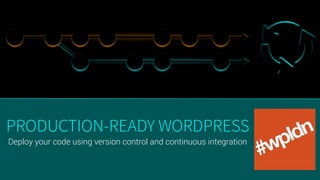
Production Ready WordPress #WPLDN
- 1. Deploy your code using version control and continuous integration PRODUCTION-READY WORDPRESS
- 2. • Presenter • Front End Developer • Senior Sales Engineer - WP Engine • Music Technology Edmund Turbin @spicecadet
- 3. Production Ready Wordpress Contents The Problem The Solution The Script Demonstration Learnings Deployment, version control and continuous integration
- 4. The Problem
- 5. Deploy your site • Manage the way code is deployed • Automate repetitive tasks for devs, admins when changes go live • Make it easy to use best practices • Allow for flexibility, multiple deploy processes, safe testing
- 6. The Solution
- 7. The Solution • Develop Locally • Distributed Version Control • Don’t keep plugins and WP core in repository • Deploy to testing environment prior to production • Automate build and testing
- 8. Continuous Integration • Multiple developers share code • Several pushes per day • Each push verified by automated build • Avoids “integration hell” • Teams can detect problems early
- 9. Workflow • Local Development • Central Version Control • Continuous Integration Pipelines • Build Script • Dependencies • Push to server
- 16. Tools
- 17. Theme
- 19. Build
- 21. Dependencies
- 29. The Script
- 35. DemonstratioN
- 36. Learnings
- 37. Codeship • Uses a virtual machine at time of deploy • Has many common binaries installed, possible to install more • Caches NPM packages • Can be used in Debug mode which allows you to SSH into the virtual machine and run commands until happy
- 38. Git Integration • Understanding how to move files from Codeship was difficult • A few different attempts to make this happen • Possible to use FTP, but Git is more streamlined and quicker • git push — force option important - not all files in the repo are needed in production
- 39. Build • Gulp, Grunt, Webpack.js, etc. can all be run during deployment • Local development can use it’s own build script • Possible to use different tasks or build scripts for each branch • Allows for release management - deploy different branches to their own server environments (stage, test, production)
- 40. Next Steps • Do more testing with Assertible 😁 • Remove all source files and unnecessary files like readme 😎 • Create automated rollback functionality, look at symlinks 😵 • Wishlist: Visual Regression Testing with NPM/Wraith, Backstop.js 👊
- 42. Reference Team Collaboration with Github 7 Easy Steps to Continuous Deployment Optimize Local Development Codeship Deployment Script Post Deployment Smoke-Testing with Assertible
